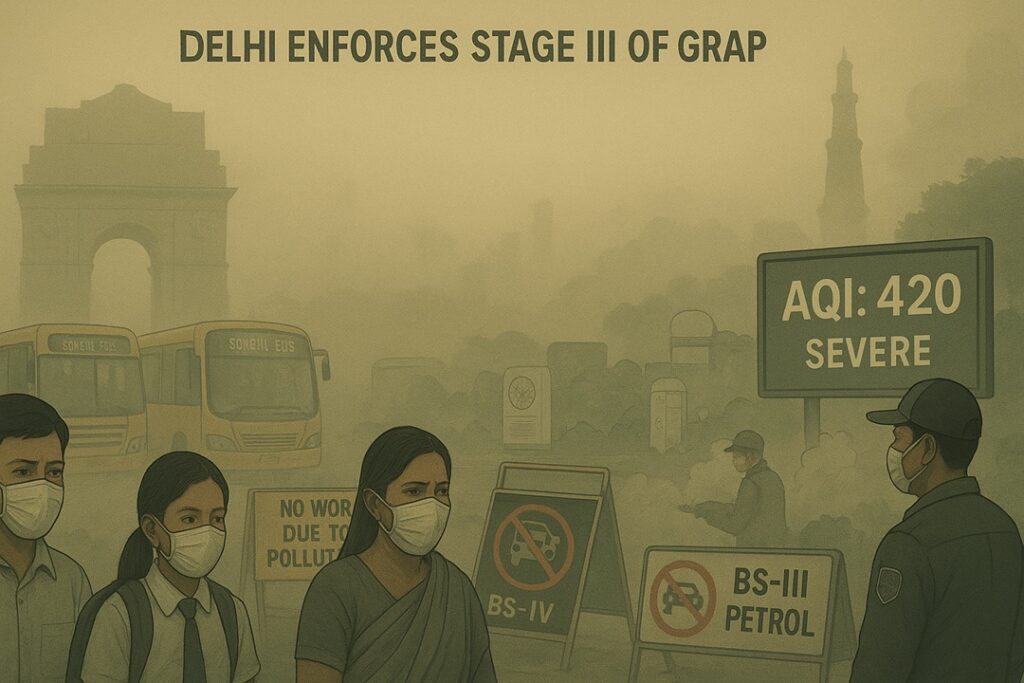Delhi Enforces Stage III of GRAP: Addressing the Air Pollution Emergency

Context
The persistent deterioration of air quality in Delhi-NCR has triggered the activation of GRAP-III measures. This stage is invoked when AQI levels fall between 401–450, indicating severe pollution levels that pose serious health risks, especially to vulnerable groups such as children, the elderly, and those with respiratory illnesses.
About Graded Response Action Plan (GRAP)
What it is:
The Graded Response Action Plan is a dynamic pollution control framework aimed at combating air pollution in Delhi-NCR through stage-wise actions based on the severity of air quality. It provides a predefined set of measures to be implemented according to specific AQI ranges.
Implementing Agencies:
GRAP is implemented by the Commission for Air Quality Management (CAQM) in coordination with the Central Pollution Control Board (CPCB), the Delhi Government, and state pollution control boards of NCR states.
Establishment:
The plan was introduced in 2017 following the directions of the Supreme Court of India, based on recommendations by the Environment Pollution (Prevention and Control) Authority (EPCA). It serves as a legal and institutional framework for air pollution management in the region.
Objective:
The main objective of GRAP is to reduce air pollution in Delhi-NCR through timely, coordinated, and graded interventions. It seeks to safeguard public health, minimize exposure to harmful pollutants, and support the goals of the National Clean Air Programme (NCAP).
Key Features of GRAP
Stage-wise Mechanism:
GRAP operates through a four-stage system linked to air quality levels:
- Stage I: Poor (AQI 201–300)
- Stage II: Very Poor (AQI 301–400)
- Stage III: Severe (AQI 401–450)
- Stage IV: Severe+ (AQI above 450)
Each higher stage includes all measures from the previous stages, ensuring a cumulative response.
Major Interventions:
Stage III restrictions include:
- Ban on construction and demolition activities
- Restrictions on BS-III petrol and BS-IV diesel vehicles
- Closure of primary schools (up to Class 5)
- Promotion of work-from-home for offices
- Encouragement of public transport use and vehicle pooling
Essential services like metro, railways, sanitation, defence, and healthcare remain operational but must adhere to dust and emission control norms.
Monitoring and Forecasting:
GRAP relies on real-time monitoring by CPCB and pollution forecasts provided by IMD and IITM Pune. These inputs help authorities to anticipate pollution peaks and invoke measures in advance to prevent further deterioration.
Implementation Mechanism
Decision-Making Process:
The CAQM Sub-Committee reviews daily AQI data and forecasts to determine when to activate or relax GRAP stages. If high pollution levels are expected to persist for three or more days, the next stage is activated proactively.
Enforcement:
Implementation is carried out by the Delhi Pollution Control Committee (DPCC), NCR state boards, and district administrations. Coordination among these agencies ensures enforcement of restrictions and public compliance through awareness campaigns and on-ground monitoring.
Conclusion
The Graded Response Action Plan represents a scientific and institutional approach to managing Delhi’s recurring air pollution crisis. While its timely activation helps mitigate immediate health risks, long-term improvement depends on sustained efforts in clean energy transition, transport management, and public participation. Effective implementation of GRAP, supported by regional cooperation, remains crucial for achieving cleaner and healthier air in the NCR region.
source : HT
